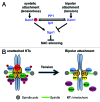The current view for the silencing of the spindle assembly checkpoint
- PMID: 24776751
- PMCID: PMC4111715
- DOI: 10.4161/cc.29027
The current view for the silencing of the spindle assembly checkpoint
Abstract
Chromosome bipolar attachment is achieved when sister kinetochores are attached by microtubules emanating from opposite spindle poles, and this process is essential for faithful chromosome segregation during anaphase. A fundamental question in cell biology is how cells ensure that chromosome segregation only occurs after bipolar attachment. It is well documented that unattached kinetochores activate the spindle assembly checkpoint (SAC) to delay chromosome segregation. Therefore, the silencing of the SAC is thought to trigger anaphase onset, but how correct chromosome attachment is coupled with SAC silencing and the subsequent anaphase onset is poorly understood. The establishment of chromosome bipolar attachment not only results in the occupancy of kinetochores by microtubules but also applies tension on sister kinetochores. A long-standing debate is whether the kinetochore attachment (occupancy) or the tension silences the SAC. Recent work in budding yeast reveals the SAC silencing network SSN that prevents SAC silencing prior to tension generation at kinetochores. Therefore, this signaling pathway ensures that SAC silencing and the subsequent anaphase onset occur only after chromosome bipolar attachment applies tension on chromosomes. This review will summarize the recent advances in the understanding of the SAC silencing process.
Keywords: checkpoint control; chromosomes; mitosis; yeast biology.
Figures

References
Publication types
MeSH terms
Substances
Grants and funding
LinkOut - more resources
Full Text Sources
Other Literature Sources
Molecular Biology Databases
